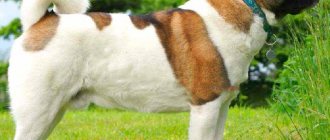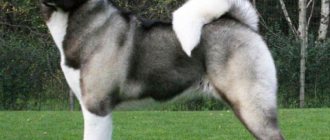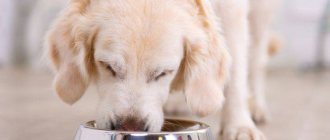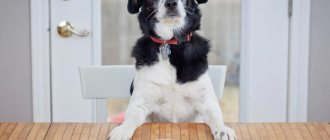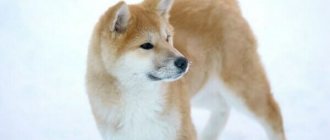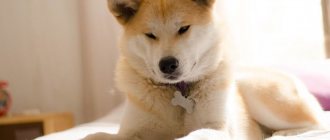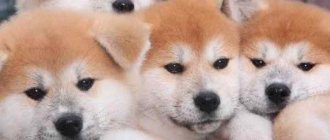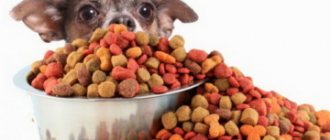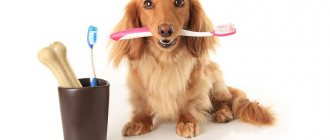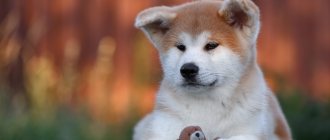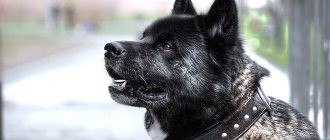The American Akita, known as the large Japanese dog, has the following characteristics:
- balanced psyche,
- strong hunting instinct
- loyalty to the owner
- often stubborn character
- good health and good immunity,
- unpretentiousness in care,
- the need for full walking,
- demands for quality nutrition,
- cleanliness, absence of a specific odor,
- reluctance to vote without reason.
This Japanese breed comes from the province of Akita, and it received the “American” prefix thanks to the soldiers who brought it to the United States. Outwardly, the pet resembles a cute bear cub with wise eyes. However, the breed cannot be called easy for beginners.
Characteristics of the American Akita dog breed
Male:
Bitch:
Price:
Lifespan: 10–12 years. |
| Is it difficult to care for | Grooming is simple, the only difficulty is combing the fur during the molting period. |
| Where is the best place to keep it? | They can be kept in an apartment, but an aviary is considered ideal. |
| What climate do they prefer? | They do not like heat; when kept in an apartment, it is necessary to provide free access to the balcony and air conditioning in the summer. |
| How often should you bathe? | They bathe rarely, as needed. Exhibition animals - before each event. |
| Are there any problems with catering? | The pet eats a little and is not prone to overeating. However, high quality feed is required. |
| How long should walks be? | They walk twice a day for at least an hour. Walking is preferred. |
| Is it normal for the American Akita to have long hair? | A person with long hair is called a long-haired Akita. This feature is considered the result of a genetic failure. The dogs look impressive, but breeding them is prohibited. |
| Are there any difficulties with parenting? | This is a breed with a strong character and requires the same training. |
| What health problems might there be? | Joint problems are possible, as with other large breeds. |
| Who is the breed not suitable for? | Soft and weak-willed people, elderly people. |
| Can I buy for a child? | An Akita will happily play with a child, but raising a pet can only be done from the age of 14. |
| Is it possible for people without experience in keeping dogs to own one? | This is a difficult breed to train. It can only be started by those who are willing to spend time on classes and people who are used to getting their way. |
| What kind of work can they do? | Akita is a multifunctional breed. A dog can be a companion, hunter, nanny, watchman, security guard, guide. |
| Can it be kept with other animals? | Not recommended. They do not show aggression towards people, but they can be aggressive towards their own kind. And cats can simply become their prey. |
| Is it true that the American Akita cannot bark? | This is a silent breed, but it can bark. He gives his voice only when there is really a need for it. |
| Are American Akita and Akita Inu the same breed? | No, these are two different breeds with their own standards. They cannot be crossed. The Akita Inu is softer in character. The American Akita has a complex character and stronger bones. |
Advantages of the breed
- A strong, beautifully built, imposing dog that evokes sympathy.
- Balanced temperament and orientation towards communication with the owner.
- Great devotion to family. He loves everyone, but especially singles out one person from the “pack”.
- He never panics when it comes to protecting his owner and knows how to make decisions in extreme situations.
- Despite its large size, it is suitable for keeping in a country house, apartment and even on the street.
- Can be used for guarding, hunting and as a companion.
- He loves children and does not show aggression towards them even in games.
- It is characterized by cleanliness and the absence of a specific odor.
- Has good health, good immunity, and is characterized by the absence of genetic problems.
Flaws
- The dog is large and needs more space than a small pet.
- The dog has a strong self-sufficient character and can be stubborn.
- Suitable only for strong people who are ready to insist on their own.
- Beginners with an Akita will find it difficult. She has nothing in common with a shepherd; the pet has its own understanding of obedience.
- Characterized by excessive independence, the consequence of which is a tendency to escape.
- The hunting instinct can manifest itself at the most inopportune moment, for example, while walking in the park, when you see a cat running by.
- If you have an American Akita dog, you must be prepared to walk without the company of dog lovers. She is not very friendly with her brothers.
What to feed an American Akita
Many dog breeds are fed in one mode, either dry store-bought food or natural homemade products and very rarely mixed, i.e. alternating dry with natural. In the case of Akita, you can resort to all three options, but it is worth considering that store-bought food is not always suitable for the dog.
Dry food
When purchasing ready-made dry food, always pay attention to the composition. There should be no soy, no chemical elements, only one type of protein is allowed - fish (salmon, tuna, sardines) or duck. The protein content in the feed is at least 26%, and carbohydrates and fats - 12-18%. Rice or potatoes can be allowed as a source of carbohydrates, but in no case wheat, corn or oats.
Holistic-class feeds have an optimal composition. Quality products are produced by Purina Pro Plan; their range includes food based on salmon with rice or lamb with rice porridge. The food is suitable for both babies and adult pets, but choose leaner foods for babies.
Puppies who are 5 months old are transferred to three feedings a day, and from 7-9 - to twice a day. A single serving is 10% of the total weight of the dog. On foods with an age mark, the instructions clearly indicate the dosage, you can adhere to it.
Wet food
In addition to dry food, manufacturers offer wet food in the form of pate or goulash. Let's figure out which is better.
Pros of wet food:
- Does not cause thirst in dogs;
- They have a soft texture without damaging tooth enamel;
- The risk of choking on a dry piece is reduced;
- Simple dosage;
- No dyes or other chemical components.
READ What to feed a miniature pinscher 1 month - miniature pinscher feeding
Natural nutrition
Naturally, it is better to feed natural rice porridge with the addition of fresh boiled fish, eggs, cottage cheese or grated vegetables, but the dog will quickly get tired of such a narrow menu every day. Therefore, you can alternate natural dishes with dry or important food. This is not very correct, but in the case of Akita Inu, this is the best option, allowing you to saturate your pet’s body with all the necessary vitamins and microelements.
Unlike the Japanese breed, the American Akita can be fed meat, vegetables, fruits and cereals. Her diet may include:
- Meat (beef, horse meat, lamb);
- Boiled poultry and offal;
- Porridge (buckwheat, rice, oatmeal);
- Dairy products;
- Milk, but only for puppies up to 6 months;
- Boiled and raw vegetables, fruits, berries, limit the amount of potatoes.
It is strictly forbidden to give the American Akita:
- White bread;
- Sweets;
- Confectionery;
- Animal bones, birds;
- River fish;
- Pork and lard;
- Potato;
- Pasta.
Ready-made dry and wet formulas for Akita Inu can be a simple solution to the nutritional issue. They contain everything you need, because manufacturers have already taken care of the correct ratio of all nutritional components. We are talking about formulas based on rice, salmon or tuna. Some dogs of this breed do well on food containing lamb, rabbit, duck and rice.
Only premium and super-premium mixtures, which are sold in specialized stores, are suitable for feeding Akita. If the packaging says “natural”, the food contains natural products, “holistic” - the formula is suitable for dogs with food intolerances and allergies, “human-grade” - the ingredients are suitable for human consumption. All of these mixtures are suitable for Akita Inu.
A good food must meet the following criteria:
- One source of protein: fish (tuna, salmon, anchovies, sardines), sometimes duck works well. Akita Inu rabbits and lambs are generally ignored. Soy is strictly prohibited.
- Protein content – 21-26%, fat – 12-18% (that is, the food must be holistic-grade).
- The source of carbohydrates is rice (the addition of potatoes, barley, oats is acceptable). Feeds containing wheat or corn are excluded.
When selecting industrial mixtures, carefully read the composition on the back of the box. If the label says “salmon and rice,” there is no guarantee that organ meats, chicken, and other grains were not actually used. Akita Inus of Japanese origin are especially sensitive to unsuitable food.
Since it is now difficult to find suitable holistic-class mixtures on the Russian market, Purina Pro Plan “Salmon with Rice” food can be used as an alternative. Good reviews are also given on GO! NATURAL Holistic, Acana, Pronature Holistic, Natur Line “Lamb with Rice”. The dosage is selected at the rate of 400-500 g of dry food per 30 kg of dog weight.
Longhaired American Akita
A long-haired individual can appear in almost any litter. But I must say, this does not happen so often. The reason for this phenomenon is a gene that may not appear in the phenotype of dogs for a long time. The probability increases to 25% if both producers are carriers of the gene. The appearance of such pets is considered by many to be even more attractive than that of standard representatives of the breed. The longhaired variety of the breed has longer hair on the ears, tail, face and paws, and forms “pants” on the limbs.
Breeders note that Longnecks are devoted pets without signs of aggression. However, long hair is more difficult to care for and requires regular brushing. And an exhibition career is not for these impressive beauties. They are rejected in the rings, and breeders often sell such puppies as breeding marriages, making a corresponding note in the pedigree. Longtails are also not allowed for breeding.
American Akita: dog character, behavior
The large Japanese dog is very loyal to its owner. She singles out one person from the pack and is ready to follow him to the ends of the earth. As a rule, this person is a strong leader. This can be either a man or a woman. She becomes less attached to other family members. But the worst punishment for her is loneliness. It is absolutely contraindicated for her. Left to its own devices, the pet begins to get mischievous and its character deteriorates. The consequences of loneliness may be irreversible.
The most pronounced character traits of the American Akita:
- focused on communication with the owner,
- selfless devotion to the owner and family,
- patience and calmness in the absence of strong irritants,
- independence that needs to be channeled in the right direction.
Behavior at home
The American Akita dog breed has many feline traits in its character. She will follow her owner's heels, caress her, and won't mind crashing on the couch with him. Unless he won't purr. You will rarely hear your pet's voice. You can't call a pet a windbag. It attracts the owner's attention only when there is a real danger to him or the owner. Unless the loud-voiced relatives living nearby teach him to bark. It must be said that with pets living under one roof, a large Japanese dog can exist peacefully. But for this, the owner needs to show great patience in raising him.
Behavior on the street
This is the dominant breed. The American Akita is a dog that expects obedience from other members of the pack, and especially from strangers. Owners need to be attentive to any manifestations of aggression on its part. This is usually true outside the home. While walking, Americans love to get into fights. Males are more prone to this behavior, but there are also cases of fights between females. This always happens unexpectedly, so it is better to minimize contact between pets and other relatives.
A socialized dog is not aggressive towards strangers, which is confirmed by the characteristics of the breed. But this does not mean that you can allow people you meet to play pranks with him. The pet may perceive such games as an attack, then a conflict is inevitable. Dog handlers do not recommend that strangers look an Akita directly in the eyes, and especially bend over when doing so. The dog perceives this behavior as aggression. Experienced owners assure that the American Akita always distinguishes imaginary danger from real danger. This is a really smart dog, but it all depends on its level of socialization, so it’s not worth the risk.
Attitude towards children
The dog allows children a lot. He can play with them or calmly wait until the owner’s kids calm down and stop trying to pull his ears. But all patience may come to an end. Even such a calm and peaceful dog can harm a child. And although some manage to use her as a nanny, it is still not recommended to leave such a large dog as the American Akita alone with children. The description of the breed suggests that aggression is not typical for it. But in the heat of the game, she can drop the baby, trample on him, thereby seriously injuring him. To do this, she doesn’t even have to make any special efforts; her considerable weight will do everything for her.
What not to give to an Akita Inu
Akita Inus are very picky eaters, so you should plan their diet carefully. But there is a certain list of foods that are best excluded from your dog’s diet:
- sausages;
- foods high in salt;
- spices;
- food with chemical additives;
- smoked and pickled foods;
- river fish (as it has a lot of small bones);
- raw meat and raw fish (to prevent helminths from entering the animal’s body);
- all sugar-containing foods: Akita Inus have a hereditary predisposition to diabetes.
Dry food for Akita Inu
The best way to feed dogs, including Akita Inu, is dry food.
It contains all the necessary vitamins and microelements that are needed to maintain the health of the dog. But selecting food can take a long time, since these Akita Inu are very scrupulous about everything that ends up in their plate. Be prepared for your pet's whims. But do not think that any refusal of food means a whim. Sometimes this is a signal that the dog is sick or you are serving poor quality food.
How to choose the right food:
- Do not buy cheap food, as “true gourmets” simply ignore them. Only super-premium or premium-class dry food and canned food are recommended.
- If soy is present in the food, then you should not feed it to your Akita Inu. Large amounts of protein are harmful to Asian dogs.
- Wheat and corn are two other ingredients that should not be in exotic breed dog foods. They can negatively affect the functioning of the gastrointestinal tract and the general well-being of a dog that is not accustomed to such food. Choose dry food that contains fish, meat, rice and bone meal.
- Look on the package of food for the daily portion of BZHU. For example, the daily fat intake for puppies should not exceed 18%, while babies need at least 25% protein.
- Do not buy universal food designed for all breeds and ages of dogs. The food must be appropriate for the age category of the dog.
- If you are unable to choose food for your pet on your own, contact a specialist.
The main advantages of ready-made food for Akita:
- balance;
- ease of feeding;
- accessibility;
- diversity;
- the presence of hypoallergenic and medicinal types.
We are talking about premium, super-premium and holistic food.
Flaws:
The main drawback is the price category. They are available in any pet store, but the cost is quite high. For example, a bag of Acana food with fish weighing 13 kilograms costs about 6,000 rubles. If we consider economy class brands, then they have a poor composition. Given the relative cheapness, it is impossible to feed the Akita Inu with such food.
American Akita care: coat, eyes, ears
If not everyone knows how to approach raising an American dog, then the question: how to care for an Akita rarely arises even among inexperienced owners. Everything is as usual - hygienic care of the coat, ears, teeth, feeding, bathing and regular walks. A separate point is the molting period.
Conditions of detention
It is better to give preference to street education. The breed was bred in the mountains, is not afraid of the cold, and its pads are adapted for walking on snow. The American Akita feels great in an enclosure with a warm booth. Moreover, she will sleep there only in the coldest winters. The situation is worse in the heat. It is imperative to provide shelter from the sun, and water should always be freely available. But in a house, and even an apartment, this breed feels quite good. Only in this case you need to provide her with daily walks, preferably several times a day.
Grooming
When your pet begins to shed, it needs to be brushed every day with a slicker brush. The dog sheds its fur and undercoat most actively in the autumn-spring period. And since he belongs to the group of Spitz and primitive dogs, he is combed against the grain. The fur on the chest is difficult to brush; in this area you need a sparse comb with longer teeth. These areas are also combed against the grain.
Pets are rarely bathed - only if the fur feels dirty or when touched, a dirty mark remains on the hand. Water procedures are usually organized no more than 2 times a year. The situation is different with show dogs. They are washed frequently, even every week during exhibitions. To do this, use only special shampoos, balms and conditioners.
Eye hygiene
A healthy dog's eyes should always be clean. Unless after sleep, secrets accumulate in the corners. Green, yellow, especially bad-smelling discharge from the eyes is a sign of the disease. If they appear, you should immediately show the dog to the veterinarian. And ordinary hygiene care consists of wiping the corners of the eyes with a cloth.
Ear hygiene
This breed's ears are open and dirt often accumulates in them. Clean them with a piece of gauze as needed. Cotton swabs are not suitable. Firstly, they are too short, and secondly, they can damage the ear canal. If there is severe dirt in the ears, use a cleansing lotion that dissolves wax and dirt. It can be purchased at a veterinary pharmacy or specialty store.
Dental care
Teeth require special attention during their replacement period. This happens around 4 months of age. You need to make sure that they do not stay in the mouth for more than the prescribed period, otherwise your pet’s bite may deteriorate. In adults, if necessary, plaque on the teeth is removed and the health of the gums is monitored.
Nail care
Active dogs usually wear down their own nails. In winter, they often have to be pruned using special pliers. This is done carefully so as not to damage the living part of the claw.
Age characteristics
The needs of a dog's body change as it grows and develops. The health and well-being of your pet depends on a properly selected diet.
Up to two months
In the first weeks after birth, the puppy feeds on mother's milk, which contains all the necessary nutrients. At this age, Akita Inu puppies need to be fed about 6 times a day: at 7:00, 10:00, 13:00, 16:00, 19:00, 22:00. If your pet came to you before the age of two months, you can use special industrial milk. Then complementary foods are gradually introduced into the diet.
At two months
At this age, small Akita Inus are usually “weaned.” Puppies can have a hard time being separated from their mother. The first two days of being in a new place they whine. Many owners try to relieve anxiety with food, and as a result, Akitas experience the first food poisoning in their lives. To avoid this, ask the breeder in advance what kind of food the puppy ate with its parents.
Use puppy food. It can be finely crushed and dissolved in special milk for weaning. The volume should be such that the dog is full. Continue feeding 5-6 times a day at the same time. Gradually, low-fat calcined cottage cheese, sea fish, and finely chopped boiled veal are introduced into the diet. Once a week, be sure to give a boiled egg.
It is very convenient to use ready-made food. Natural food should only be freshly prepared and warm (not cold, not hot). If within 20 minutes the puppy has not eaten the food offered, remove the bowl and do not offer other food until the next feeding.
At three months
At this age, the dog grows very quickly. Due to increased activity, four meals a day and water consumption should correspond to the daily diet of an adult dog. At the same time, the quality of food should change. The puppy is given more fish and meat than dairy products. To make the food more dense, small fish is added to the soaked food, half mixed with rice porridge.
This food is more suitable for the needs of Akita Inu than market dog food. Pay attention to your pet's appetite and needs, as well as the condition of its feces, skin, fur and muscles.
Meals are switched to three meals a day: at 7:00, 12:00, 17:00 and 22:00. A healthy Akita puppy should not be overly thin or overweight. Do not feed your pet; make sure that its sides do not “swell” after a meal. If the food remains in the bowl, you can reduce the portion by half until the Akita learns to eat all the food offered. And on the contrary: if the baby licks the bowl for a long time, it means there is not enough food and it should be added.
Never give your puppy game bones, poultry, sausage, pork, ham, fatty cheeses, bread, pasta and raw river fish. Also avoid legumes, sweets, potatoes and other foods that your dog doesn’t need. When feeding ready-made industrial formulas, your pet does not need additional mineral and vitamin complexes.
After six months
Energy for normal development requires less and less energy, mainly the skeleton develops. Therefore, the diet should no longer be so high in calories. If you continue the same feeding regimen, your pet will quickly gain excess weight and the bones will begin to deform. It is better for the puppy to be thin.
At the age of 6-12 months, the Akita is transferred from Pappy food (for puppies) to Junior. Gradually they begin to add adult formulas to the diet. Vegetables can be grated, meat can be cut into larger pieces. Cottage cheese and fermented milk products should only be low-fat.
Adult dogs
The diet of a mature Akita does not change significantly. Gradually the dog is transferred to two meals a day. The main amount of food should come in the morning. It happens that with low loads and a sedentary lifestyle, Akitas eat once every two days.
Old age
The first signs of a dog's impending old age are:
- graying of fur (first on the face);
- deterioration of hearing and vision;
- low activity;
- irritability.
If these signs occur, you should reduce the fat and calorie content of your diet (6-9% fat, 15-20% protein), and at the same time increase the amount of fiber to 5%. Add more pureed vegetables to your food, but not cereals. Give your pet low-fat fermented milk products. You don’t have to cook fish and meat, but simply freeze them. There is no point in grinding them. If your older Akita has bad teeth, simply cut the fillets into smaller pieces.
For an aging dog, the “Light” and “Senior” formulas are suitable. When planning a feeding diet for an older Akita, listen to your veterinarian's recommendations.
At two months
It is very convenient to use ready-made food. Natural food should only be freshly prepared and warm (not cold, not hot). If within 20 minutes the puppy has not eaten the food offered, remove the bowl and do not offer other food until the next feeding.
At three months
Walking and exercise
This is a multifunctional dog that was bred to hunt bear, wild boar, and deer. The couple can hold the bear until the hunter comes. In Japan they were used to drive fish into nets. They can bring the duck to local hunters without damaging the carcass. You can train an American Akita to be a guide dog, or you can teach it to pick mushrooms. In any case, a walk with her will not be boring.
Beginning dog breeders often think that the American dog needs intense exercise during walks. Actually this is not true. Yes, she loves to walk, but prefers to do it slowly. A long distance is not a problem for her, she just wants to overcome it by walking, but not by running. The attitude of different individuals to water differs - some like to swim, others do not come close to the water.
Industrial feed
Ready-made dry and wet formulas for Akita Inu can be a simple solution to the nutritional issue. They contain everything you need, because manufacturers have already taken care of the correct ratio of all nutritional components. We are talking about formulas based on rice, salmon or tuna. Some dogs of this breed do well on food containing lamb, rabbit, duck and rice.
Only premium and super-premium mixtures, which are sold in specialized stores, are suitable for feeding Akita. If the packaging says “natural”, the food contains natural products, “holistic” - the formula is suitable for dogs with food intolerances and allergies, “human-grade” - the ingredients are suitable for human consumption. All of these mixtures are suitable for Akita Inu.
A good food must meet the following criteria:
- One source of protein: fish (tuna, salmon, anchovies, sardines), sometimes duck works well. Akita Inu rabbits and lambs are generally ignored. Soy is strictly prohibited.
- Protein content – 21-26%, fat – 12-18% (that is, the food must be holistic-grade).
- The source of carbohydrates is rice (the addition of potatoes, barley, oats is acceptable). Feeds containing wheat or corn are excluded.
When selecting industrial mixtures, carefully read the composition on the back of the box. If the label says “salmon and rice,” there is no guarantee that organ meats, chicken, and other grains were not actually used. Akita Inus of Japanese origin are especially sensitive to unsuitable food.
We invite you to familiarize yourself with: Paste for removing hair from cats (15 photos): how to choose a paste for dissolving lumps in the stomach of cats? How to give it correctly?
Since it is now difficult to find suitable holistic-class mixtures on the Russian market, Purina Pro Plan “Salmon with Rice” food can be used as an alternative. Good reviews are also given on GO! NATURAL Holistic, Acana, Pronature Holistic, Natur Line “Lamb with Rice”. The dosage is selected at the rate of 400-500 g of dry food per 30 kg of dog weight.
Only premium and super-premium mixtures, which are sold in specialized stores, are suitable for feeding Akita. If the packaging says “natural”, the food contains natural products, “holistic” - the formula is suitable for dogs with food intolerances and allergies, “human-grade” - the ingredients are suitable for human consumption. All of these mixtures are suitable for Akita Inu.
Since it is now difficult to find suitable holistic-class mixtures on the Russian market, Purina Pro Plan “Salmon with Rice” food can be used as an alternative. Good reviews are also given on GO! NATURAL Holistic, Acana, Pronature Holistic, Natur Line “Lamb with Rice”. The dosage is selected at the rate of 400-500 g of dry food per 30 kg of dog weight.
Tendency to diseases, vaccinations
Like other large breeds, the American Akita often suffers from joint-related diseases. This is dysplasia of the hip and elbow joints. American women may suffer from diseases of the eyes, heart, and thyroid gland, which are inherited. Responsible breeders exclude such dogs from breeding. Overall, this is a healthy breed with good immunity.
Vaccinations, anti-worming treatments
Only absolutely healthy dogs can be vaccinated. 10 days before vaccination, puppies are given an anthelmintic. Dosage - according to the instructions, strictly according to the weight of the pet. Subsequent dewormings are carried out monthly until 6 months of age, then every 4 months.
Approximate puppy vaccination schedule:
- 8 – 9 weeks – complex vaccination against plague, adenovirus, parainfluenza, parvovirus + against leptospirosis,
- 12 weeks – revaccination + rabies vaccination,
- 1 year and then annually - repeated revaccination + rabies vaccination.
What to feed?
There are no particular problems with organizing food for American Akitas. You just need to decide what kind of feeding the Akita will be (ready-made diets or natural feeding) and establish a diet. Adult dogs are usually fed twice a day, no earlier than 1.5 hours after a walk.
Puppy diet
Before feeding your Akita puppy, find out what kind of food he received from the breeder. After changing homes, he should receive exactly the same food. After a week, he can be switched to a different type of diet. The diet will depend on the type of constitution. Light, non-boned puppies are fed like other breeds. Large bony puppies require more attention to nutrition. This is due to the structural features of the pet’s skeleton. Babies need various mineral supplements with the addition of chondroitins and glucosamines for the full formation of the skeleton.
Feeding mode:
- 2 month old puppies – 5 times a day,
- 3–4 menstruation – 4 times,
- 4–12 months – 3 times,
- starting from one year - 2 times a day.
It is more convenient to use ready-made dry rations of at least premium class as feed. Cottage cheese, lactic acid products, fruits, and vegetables are added to them. For puppies, food can always be on the table, they have a sense of proportion, so the kids don’t overeat or overeat. And they practically never steal food from the table. Just keep in mind that you cannot give dry and natural food at the same time.
Adult dog diet
Most breeders feed the American Akita with ready-made food. “Natural food” takes too much time, and creating a balanced diet is quite difficult. The basic rule is to maintain a balance of substances. To do this, they use the formula: 50% meat and 25% vegetables and cereals, as well as vitamins and minerals.
Suitable cereals include buckwheat, rice, and oatmeal. Semolina, millet, and legumes are excluded from the menu. Meat – only lean (beef, veal, boneless poultry, offal). Adult dogs are not given milk because it is not digestible. Fermented milk products and cottage cheese are useful. Vegetables include carrots, beets, cabbage, raw or boiled. Many pets love apples, plums, and raspberries.
Dandelion leaves and greens can serve as a source of vitamins. Morksa cabbage and brewer's yeast work well. You should not give your pets lard, smoked meats, pasta, river fish (it is often infected with helminths), or sharp bones.
Feeding the puppies
Like any other purebred dog, it is better to buy an Akita not from an ad, but from a specialized nursery. Experienced breeders keep their pets properly, do not chase the number of puppies, and value their reputation.
It is most advisable to purchase puppies that are already 2 months old. After all, by that time they already have the necessary vaccinations (which should be indicated in the veterinary passport), and they also went through the branding procedure, receiving a puppy card.
You should immediately decide on the gender of your future pet. Girls grow up to be smaller, calmer and more loyal. Large boys are more likely to show arrogance and stubbornness and are more difficult to train.
The character of American Akita puppies can only be assessed from the words of the breeder, based on the genetics and behavioral characteristics of the parents. After all, kids are all active, emotional and energetic.
READ Californian breed rabbits maintenance and feeding
If in the future the owner plans to exhibit his pet, then it is necessary to inspect the puppy’s exterior for compliance with the breed standard. In addition, the baby must be healthy, well-groomed and not have an unpleasant odor.
The cost of representatives of this breed varies from 20 to 50 thousand rubles, and even more. The price depends on the puppy's pedigree and compliance with the standard.
A dog can live both in an apartment and on the street. In the first case, it is imperative to provide the dog with regular long walks. For outdoor keeping, you need to build a spacious enclosure, and if you let him out for a walk in the yard, fence it off with a high fence for the safety of your neighbors.
The dog acclimatizes to different temperature conditions. Wool provides reliable protection from any frost. True, dogs don’t really like heat.
Caring for a dog is not too difficult. It is necessary to accustom oneself to all procedures from an early age, while American Akita puppies are small.
- Brush the coat once a week, when shedding - every day, maybe several times. Akitas shed very intensively, so in spring and autumn you need to carefully monitor the cleaning of lost hair.
- Bathe your dog once every 3-4 months. If it gets very dirty, wipe it with a damp cloth.
- Clean ears, teeth and eyes as they become dirty.
- Walk your dog regularly every day for at least 2 hours.
The American Akita needs to be fed twice a day, puppies - 3 or 4 times. First, the baby must be given the food he received from the breeder. In six months you can switch to other options.
You can buy ready-made super-premium or premium food, saving time if you are not able to monitor your dog’s diet yourself.
From the day the puppy is purchased, all responsibility for its health falls on the owner. To ensure that your pet does not suffer from indigestion and grows healthy, create a weekly menu that is varied and balanced.
When buying a puppy, carefully read the usual food for him, which he received with his mother in the nursery. Continue feeding the same foods at home, gradually introducing new ingredients.
Best suited:
- Skim cheese;
- Boiled eggs;
- Boiled sea fish without bones;
- Boiled veal;
- Grated vegetables and fruits;
- Ground seaweed.
If you are new to owning a dog of this breed, it is worth consulting with your veterinarian about feeding your puppy. He may prescribe supplements in the form of special vitamins and minerals.
Training and education
Before you get a cute puppy, you need to know how to raise an American dog. This is a breed that needs to be negotiated with. They say she needs a firm hand, but with a soft glove. The dog will not follow the same commands if he does not see the point in them. You shouldn’t take him to the site for a training course (OCD) if you don’t know what to do there. He won’t understand why he needs to carry out the same commands day after day. The “stick” method also does not work; it is better to use the “carrot”.
The most difficult period for a dog is growing up. Training an American Akita during puberty requires special skills. The puppy has attacks of superiority over people. How you go through this period will determine who will be the boss in your house. You don’t need to raise your voice often at your Akita, and you shouldn’t hit him at this time. But if a grown-up puppy opens its mouth at its owner, you need to grab it by the lower jaw and hold it until the pupil realizes his guilt.
The genes of this breed have a desire to protect the owner. This is the nature of the American Akita. Therefore, special attention should be paid to the “Place” command. Otherwise, the dog will sleep by your bed, wait under the kitchen door and watch all your movements around the house. Important commands are also “Near”, “To me”. If the dog has not yet mastered them, do not let him off the leash on the street.
Choosing and caring for a puppy
If you're going to get a puppy, then get the best one. With such a desire, a person comes to the nursery, and then the breeder assures him that this 2-month-old baby will definitely become a champion. Avoid such nurseries. It is unrealistic to see a future champion in a baby before the age of 9 months. Even at exhibitions they are assessed only for their potential; they do not receive exhibition ratings.
But who knows puppies better than the breeder? They are constantly in his sight, which means he sees all their shortcomings, knows their temperament and understands the prospects of each. Ideally, the breeder should be your advisor in choosing a puppy. But in practice things happen differently. Therefore, if you are choosing your first American Akita, take a person who knows the breed standards to the groom.
Meet the baby's parents, see the conditions in which they are kept. And always choose only a healthy puppy. If you plan to participate in exhibitions in the Russian Federation, ask who issued the pedigree. A document from the RKF (Russian Cynological Federation) is required.
How to care for a puppy?
Before the baby arrives, you need to prepare a sleeping place for him and purchase the necessary equipment to care for him. These are a slicker brush, a metal comb and a nail clipper. You will also need a wide collar and a leash 3–5 meters long. To organize feeding and for water, you need two bowls on a tripod with a volume of 3 liters each.
American Akita puppies require careful handling. They are large, and at the same time overly active, trying to jump, run and overcome obstacles. However, their fragile skeleton is not ready for such loads, so during this period babies may have serious injuries to their paws. Calm them down before this happens.
In the first days, the pet must get used to the new environment. 12–14 days after the second vaccination, you can go for walks with your pet. And don’t put off raising your baby until later. He must immediately feel that he will have to obey. Errors in parenting will be difficult to correct.
American Akita breed standards (FCI Standard No. 344)
| FCI classification | Group 5. Spitz and primitive type dogs. Section 5. Asian Spitz and related breeds. |
| Usage | Companion dog |
| Appearance | A large, harmoniously built dog, with a powerful body and massive bones. |
| Important proportions |
|
| Temperament | Receptive, friendly, attentive, obedient and courageous. |
| Head |
|
| Frame |
|
| Limbs |
|
| Movements | Strong, free, with moderate reach and drive. |
| Wool | Thick, with dense undercoat, slightly shorter in the area of the head and paws. |
| Color | Black, red, dark red, white, gray, so-called cow (helmet head and spots on the body). |
| Height |
|
| Flaws | Deviation from the above parameters is a disadvantage. |
Origin story
The ancestors of the American Akita are Japanese dogs from the Akita region. In their homeland they took part in dog fights. After fighting was banned (1908), the breed began to develop as a large Japanese dog. During World War II, she had a hard time - dog skins were used to sew warm clothes and for other economic purposes. There have been attempts to save the breed by crossing it with the German Shepherd.
After the war, the breed began to revive. Her journey across the continents began. American soldiers returned home and took with them cute dogs that looked like big teddy bears. This is how the Akita came to the USA and began to be called American. In Japan, Akitas developed according to their own canons, in the USA - according to their own. Later, these two varieties were separated into separate breeds.
Supplements
Dogs with Japanese ancestry must be sure to add seaweed, which contains iodine, to their food. If the Akita receives proper nutrition, it does not require additional vitamin and mineral supplements. In spring and early summer you can feed dry yeast.
Adult dogs during lactation and puppies need specialized mineral supplements. Breeders recommend Canvit Junior vitamins, as well as Polidex supplements for joints. Canina products have proven themselves well.
We suggest you read: Feeding young cattle
Akita Inu are quite large and active dogs that require proper care, including great attention to feeding. It is necessary to choose the right food and adhere to certain rules so that the dog’s nutrition really suits it.
Inexperienced dog breeders, having bought an Akita Inu, can make an unpleasant discovery for themselves, since the pet is more likely to refuse the chicken, pork, beef, and turkey offered to it. We must remember that this breed of dog came to us from Japan, where traditionally their diet consists of rice and seafood in various forms. Therefore, if you decide to keep your dog on natural food, you will have to seriously think about creating a menu.
For good digestion, the dog must be fed rice porridge with the addition of sea fish, vegetables, and seafood. Puppies need no more than 18% fat in their diet, and no less than 25% protein. Therefore, it is necessary to give boiled eggs at least once a week, lean veal, and make sure that the dog is not allergic to it.
Adult dogs are practically not kept on natural food, since feeding Akita with natural products is very expensive and is fraught with allergic reactions. In Japan, Akita Inu eats a light and healthy diet, without dyes or preservatives. Finding such food is currently very difficult, so the owners of such dogs prefer to feed them with dry, balanced food for Akita Inu.
Dry food.
There are several rules when selecting professional food for an Akita.
In search of suitable food, you will have to run a lot, but it costs the health and cheerfulness of the dog.
Regular dog food is not suitable for Akita, since it contains several sources of essential animal protein, some of which are meat or soy, which this breed does not digest.
Allergies can occur to protein, so you need to find a fish-based diet. Wheat and corn should be avoided as they are contained as a source of carbohydrates in most foods and are not suitable for Akitas; dogs are not accustomed to such foods. The main source of carbohydrates in their diet should be rice.
I would like to separately touch on the topic of keeping an Akita, namely feeding. The fact is that the first thing you can hear when you say “AKITA” in professional circles is – oh, they are terrible allergy sufferers, they are allergic to EVERYTHING, they are always sick...
This is partly true. PARTLY. Because our dogs, thank God, are healthy and happy, have luxurious, bright fur and healthy skin. Of course, a lot depends on the genetically laid foundation. But, besides this, we know how to keep an Akita.
In their homeland, Japan, Akitas eat exclusively rice, fruits, vegetables, numerous seaweed salads, fish (usually human waste) and seafood. That is, all the diversity that their native country can offer them - nothing more. Please note - the food is “light and healthy”.
When purchasing an Akita puppy, you must remember that the higher the percentage of “pure Japanese blood” in the puppy, the more strongly its digestive and enzymatic systems are oriented specifically towards such nutrition. As a rule, such Akitas give a very strong allergic response to beef, chicken and turkey, dairy products such as fatty cheeses and cottage cheese (at the same time, for example, kefir and yogurt they tolerate perfectly - precisely because the milk protein there is initially already processed by bacteria ).
And also cereals - wheat, corn, and sometimes oats. But here we can also say that, for example, Akita tolerates the meat of wild animals (elk, roe deer, deer) well. Thus, it is possible that the problem also lies in the so-called. "industrially raised animals." Those. everything that you and I eat perfectly from the shelves throughout our lives, Akita, as a delicate nature, is simply not able to digest... we have experience raising Akitas on the products of our own, “ecologically friendly” farm. These Akitas do not suffer from allergies. And yet, there are also exceptions among them.
If we talk about ready-made food, then Akita food should be selected as follows: - ONE source of protein: fish (salmon, tuna, sardines, anchovies), sometimes duck is good. As a rule, Akitas are not interested in rabbits and lambs. - The ideal percentage of protein in the food is 21-26%, fat 12-18% (i.e.
This is, as a rule, so-called feed. Holistic class, which in our country you need to manage to find in the last year). - Carbohydrates - RICE, you can add barley or oats, potatoes. Under no circumstances should you take feed containing wheat, and it is not advisable to eat corn. But corn is tolerated by many dogs of this breed.
From food containing too high an amount of protein, an Akita may develop an allergy, or rather, oversaturation, inability to absorb protein. The eyes begin to “cry”, leaving red tracks on the face, reddish-brown discharge appears in the ears, and all this can end in very serious dermatitis and digestive problems.
And yet, all dogs are very individual. For example, with the disappearance of holistic feeds with a suitable composition from the Russian market, we were forced to look for an alternative. Found - ProPlan (Purina) Salmon with Rice. This food contains as much as 30% proteins and contains corn. But our adult dogs switched to it very well, and have been living well on this food for more than a year now.
Attempts to switch to food that is less fatty, but containing other sources of protein (chicken, beef), invariably ended in allergic reactions. So in this case, the protein source turned out to be more important. And yet, when trying to switch to grain-free food with fish (for example, AKANA, KANIDE), the dogs began to suffer from terrible scabies RIGHT NOW, almost a couple of hours after eating.
Therefore, it is impossible for an Akita owner to understand such a high protein content in such foods (and this is over 40%!). They are probably best suited for dogs that undergo strenuous daily training, such as working huskies or malamutes. Akita does not have such loads, and Akitas eat little, just as much as they need - they will always leave the rest.
From all of the above, I want to draw a summary - feed your Akita correctly, and then you will never know what a problem dog is. Because the Akita is a naturally healthy dog. The puppy must be raised correctly, supporting the foundation that the parents and we, the breeders, lay in it.
